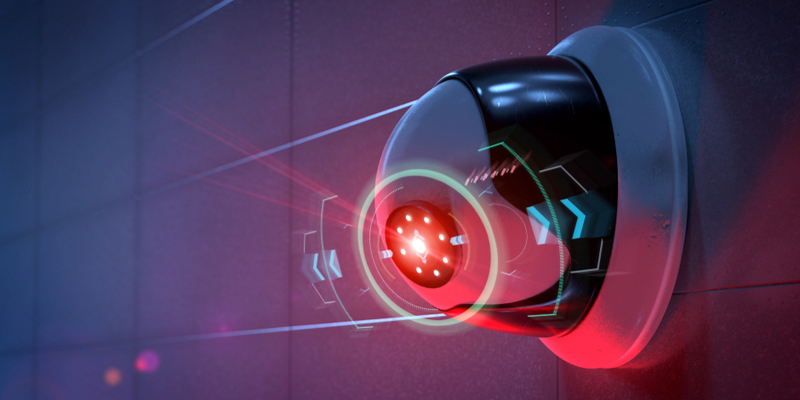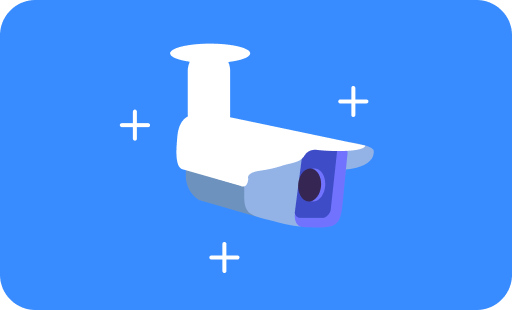CCTV Monitoring - The Ultimate Guide
- Featured Post
- Physical security

Ever wondered who can view CCTV footage, and whether operators really can watch all those monitors at the same time? We’ve answered those questions - and more - in our handy CCTV monitoring guide.
What is CCTV monitoring?
We’re all so familiar with security cameras and video monitoring that it might seem like an obvious question. However, we need to break down the term “CCTV” when we talk about different kinds of video surveillance.
CCTV stands for “closed circuit television”. This was video monitoring in its original form - analogue video cameras that send a signal to a specific set of monitors (i.e., the signals are not publicly transmitted). These cameras connect to monitors with wires and cables, which power the camera and transmit footage for it to be processed and stored digitally.
Analogue cameras need two cables to work: a power cable and a coaxial cable, which connects the camera to the network. To store footage, most analogue cameras now connect to a digital video recorder (DVR) which can be viewed remotely via an internet connection.
The newer alternative to analogue CCTV is the IP camera, which transmits live footage as a stream of data over the internet. These cameras don’t need to be physically connected to hardware to record and transmit footage, so remote video monitoring is much easier to achieve and is usually of a higher quality.
IP cameras come with in-built functions, such as motion sensors, that send alerts to monitoring stations. They also have remote controls, so it is much easier to change the angle or zoom in on a specific camera without someone needing to physically reposition it. They connect to monitoring stations with one ethernet cable, using a network video recorder (NVR). As IP camera footage is already digital, NVRs do not convert anything, they simply store footage and enable it to be viewed.
Nowadays, many CCTV monitoring set-ups also include thermal cameras. Thermal cameras use temperature rather than light to form images, which makes them ideal for settings where a normal camera would not work; for example, night time monitoring, or in very poorly lit areas.
So in a nutshell, while we still commonly refer to video monitoring as “CCTV”, the technology itself has come on leaps and bounds since CCTV was first used in its original form.
How is CCTV commonly used?
CCTV monitoring has applications in all kinds of sectors. Public CCTV is often installed in areas where local councils are looking to improve rates of street crimes and theft. Domestic cameras are the latest kind of video surveillance to gain popularity, with many homeowners installing smaller digital cameras to protect themselves from burglaries, see who’s at the door and even to check on their pets.
Other areas that benefit from CCTV monitoring include:
- large energy, industrial and manufacturing plants, where cameras can be used to check processes are running properly, and in some cases, remotely monitor hazardous areas
- construction, to protect remote sites while projects are underway
- traffic monitoring and parking
- high-security zones that require close monitoring, such as airports, maritime ports, prisons and banks.
Who can view CCTV footage?
With around 5.9 million cameras in the UK alone, who can view the footage is a common concern. If you are captured on a CCTV camera, this footage of you counts as personal data which can be used to identify you, and as such there is stringent data protection legislation in place, and restrictions on how businesses can employ video monitoring.
You can request images of yourself from businesses if you have been captured on their video monitoring systems. Under the Data Protection Act they should oblige your request within one calendar month, unless it would compromise a criminal investigation or someone else’s identity also in the footage.
Businesses must have CCTV in place for a defined purpose - so for example, if video monitoring is in place to detect and prevent crime, it should not be used to monitor employee productivity. Firms using CCTV must also inform people that they are being recorded, usually by displaying signs around the premises. The Information Commissioner’s Office has to be informed that CCTV monitoring is taking place, and companies must place controls on who can view the footage.
How do you install a CCTV system?
No matter the size, installing a remote CCTV monitoring system requires professional assistance. There are many dedicated CCTV installation companies who specialise in setting up security systems, ready for monitoring. In many cases, the installers will liaise with remote monitoring firms to ensure that all the equipment is correctly set up and transmitting footage and alerts properly.
Before setting up a camera system an installer will conduct a site survey to assess their client’s security needs, and to gain a better understanding of the site being monitored. CCTV surveys are very thorough, covering aspects such as: the type of cameras needed, camera locations, indoor and/or outdoor use, transmission methods, lighting conditions and budget.
Once the cameras have been installed, installers and remote monitoring operators will work together to conduct a “soak test”; this is a test period where all parties check that the cameras and any other equipment, such as sensors, are capturing the right information and transmitting it quickly and accurately to the monitoring station.
The soak test is also when any other remote CCTV monitoring equipment and/or technology can be tested to make sure it is successfully integrated into the system, such as alarm receiving software and intelligent video analytics.
When selecting an installer, it is important to check that they comply with industry standards. In the UK, these include the National Security Inspectorate (NSI), the Security Industry Authority (SIA) and the British Security Industry Association (BSIA). In the United States, you should look out for quality assurances from organisations such as the UL and the Monitoring Association (TMA). Around the world, many companies also adhere to ISO standards from the International Organisation for Standardisation.
Looking for an in-depth guide to CCTV monitoring? Check out Calipsa's FREE whitepaper, "Video Monitoring 2020":
How do you set up a CCTV monitoring station?
There is no one-size-fits-all way to set up a CCTV monitoring station, as it varies depending on the number of cameras, the number of operating staff and the site being protected. However, there are some overall recommendations and guidelines which ensure consistency in the way that monitoring stations are laid out and managed.
In 2016, the UK’s Centre for the Protection of National Infrastructure (CPNI) published a comprehensive guide on best practices for control rooms. A whole chapter is dedicated to Design and Build, making recommendations to:
- Consider whether to employ a guard force or use contractors, and if they’ll be on- or off-site
- Determine the size of the team and what activities they need to carry out
- Plan the physical space, from location to layout and equipment
- Ensure your detection system is fit for purpose and legally compliant
When setting up a control room, the two most crucial considerations are security, and operators’ wellbeing. The CPNI guide recommends an “open layout with clear lines of sight” to make it as easy as possible for operators to communicate with each other.
Many control rooms do not have windows, and have their own air supply. However, if the monitoring station does need windows, the CPNI suggests applying specialist film to the glass to obscure the view from outside, which protects the information within.
Operator wellbeing starts at the workstation, so it is vital that monitoring staff have a comfortable desk space with monitors set up at the correct height, ensuring that any overhead lighting does not obscure or strain their view.
How many monitors should a CCTV operator view?
CCTV operators have a challenging job: they need to continuously monitor footage on several screens for hours at a time, and then respond rapidly the moment they notice something unusual. Numbers vary from job to job, and from study to study, so there is no fixed ideal number of monitors that an operator should view. Unsurprisingly, studies have shown that the longer operators monitor screens, the harder it becomes to stay focused on spotting an event.
One study has gone so far as to suggest that “after 12 minutes of continuous video monitoring an operator will often miss up to 45% of screen activity, and after 22 minutes of viewing, up to 95% is overlooked. “ (Ainsworth, 2002, pp.20)
So how do CCTV operators manage? There are ways to set up workspaces in control centres to lessen the load. In their CCTV Operational Requirements Manual, the UK’s Home Office recommended a number of options to help operators work more efficiently.
First, ensuring the viewing area is set up properly, with no harsh natural or artificial light glaring onto screens, will make monitoring CCTV cameras much more comfortable. Screen layout is also important. One setup is the multi screen, multi view layout, which feeds in as much live information as possible. This is useful for areas that need to be continuously monitored, but this arrangement can lead to operators having to deal with information overload.
The other option is to set up “blank screen” monitors, which only become active when an alert is triggered by the camera. This allows operators to get on with other tasks when no alarms are visible. To maintain optimal security levels, a combination of both methods is commonly used. This means that operators responsible for anywhere up to 10 monitors at a time are not constantly bombarded with footage.
Another, newer way for CCTV operators to manage their workload is with video analytics. Many CCTV cameras are set up to trigger alarms when any kind of movement is detected. This means that alarm receiving centres have to trawl through alarms that were triggered by things like cobwebs on the lens, trees moving in the wind, or animals, in order to find the real alarms worth investigating.
Calipsa is a video analytics software that uses AI to detect and filter out those false alarms, helping to reduce operators’ workload so they can focus on the events that matter. We have trained our software to send through alarms that contain human activity, since these are the ones operators need to know about.
Discover even more about video monitoring and advanced analytics by checking out our in-depth guide, "Video Monitoring 2020":








16 comments